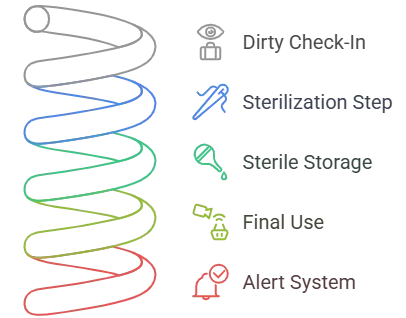
RFID for Healthcare Sterilization Compliance and Safety
Custom Your RFID Cards
In the operating room, one missed detail can trigger a devastating surgical site infection (SSI). Your hospital’s reputation and legal standing depend on one crucial factor: Can you guarantee, every single time, that every reusable surgical gown and linen has been fully sterilized before reaching the OR? For years, hospitals managed this using handwritten logs and manual checks. It is a 19th century approach to a 21st century risk. Human error and guesswork make the system unreliable. When regulators like JCAHO demand proof, a paper checklist simply isn’t enough. Today, in healthcare, the real value of RFID goes beyond just asset tracking. It focuses on automating compliance and securing patient safety with digital certainty.
The Technical Challenge: Surviving the Autoclave
Digitally tracking surgical garments isn’t easy, the real obstacle is the sterilization environment. To do the job, an RFID tag must survive a process designed to kill every microbe, which are built to endure:
- Extreme heat and pressure: Up to 135°C (275°F) and superheated, pressurized steam
- Harsh chemicals: Continuous exposure to strong detergents and sterilizers
- Intense physical forces: 60-bar water extraction and high-temp finishing machines
Only the most rugged RFID laundry tags can withstand this “hell” and deliver reliable tracking through every cycle.

The Solution: High-Temperature RFID Laundry Tags
This is why RFID laundry tags are designed for the toughest healthcare environments. PPS and high-temperature silicone laundry tags are sealed in specialized, inert materials. They provide both durability and reliable data integrity, even after hundreds of sterilization cycles. These tags form the foundation of a fully digital and audit-ready safety workflow, making sterilization compliance a certainty.
Implementation: Creating a Digital Audit Trail
Here’s how our hospital partners turn manual tracking into a reliable, digital process by updating their Sterile Processing Department (SPD) workflow:
- Dirty Check-In: Used gowns and linens are collected and scanned at a dedicated intake station. The system records them as waiting for sterilization.
- Sterilization Step: Cleaned textiles are scanned before entering the sterilizer, and again when they come out. The system creates an automatic time record for each item, proving it has completed the full sterilization process.
- Sterile Storage: After sterilization, each item is scanned as it moves into clean storage. The system updates its status to ready for use.
- Final Use: Before items are sent to the operating room or patient care area, they are scanned one more time.
If any item or cart misses a key step, especially sterilization, the system flags it and alerts staff right away, stopping it from reaching patients. This process helps prevent cross-contamination and keeps patients safe.

The Real Value: From Risk to Results
This system brings two main benefits. First and most important, you gain complete proof of safety and compliance. Every textile asset now has a full digital record. When an inspector comes, you can show a database—not just paper logs. This turns sterilization from a risk into a guarantee. Second, you see big financial returns.
- Loss Elimination: Industry-wide studies (from sources like Xerafy) confirm that hospitals reduce linen loss rates from an average of 15% down to 3% or less.
- In Brazil, one hospital saved $300,000 in a year with this system.
- In Portugal, another hospital cut its new uniform spending by more than half after better tracking its supplies.
With RFID solution, what was once a source of loss and worry becomes an area of safety and savings.
➡️ [Case Study] See the full breakdown of how RFID drives massive cost savings in our analysis: Hospital Linen Management Case Study
➡️ [Compliance Deep Dive] Learn how this system is fully compliant with HIPAA and GDPR: RFID & Data Privacy for Healthcare & Employee Uniforms
Conclusion: Safety is No Longer an Option
Stop managing 21st-century risks with 19th-century paper logs. A digital audit trail for sterilization is no longer a “nice to have”; it is the new standard of care. Your patients’ safety and your hospital’s legal and financial standing depend on it.


